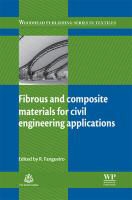Mehr lesen
Informationen zum Autor Raul Fangueiro is an Auxiliary Professor in the Department of Textile Engineering at the University of Minho! Portugal. Klappentext The application of fibrous materials in civil engineering is an important and interesting development. Steel is one of the most popular composite materials used for structural applications! however many types of steel structures are subjected to corrosion damage. The use of fibrous structures including knitted! woven and braided fabrics are becoming recognized as an attractive reinforcement due to their fiber orientation! conformability and possibility of producing shaped reinforcements. This book reviews these fibrous materials with regards to their role in structural reinforcement. Key topics include short fiber reinforced concrete! natural fiber reinforced concrete and high performance fiber reinforced cementitious composites. Zusammenfassung The use of fibrous structures including knitted! woven and braided fabrics are becoming recognised as an attractive reinforcement due to their fibre orientation! conformability and potential of producing shaped reinforcements. This book reviews these fibrous materials with regards to their role in structural reinforcement. Inhaltsverzeichnis Contributor Contact Details Woodhead Publishing Series in Textiles Part I: Types of fibrous textiles and structures Chapter 1: Natural and man-made fibres: Physical and mechanical properties Abstract: 1.1 Introduction 1.2 Natural fibres 1.3 Man-made fibres 1.4 Textile fibres for use in civil engineering applications: an overview 1.5 Natural textile fibres for use in civil engineering applications 1.6 Synthetic textile fibres for use in civil engineering applications 1.7 Fibre-matrix adhesion Chapter 2: Yarns: Production, processability and properties Abstract: 2.1 Introduction 2.2 Synthetic filament yarns 2.3 Natural fibre yarns 2.4 Synthetic yarn manufacture 2.5 Natural fibre yarn manufacture 2.6 Yarn parameters on cement reinforcement 2.7 Conclusions Chapter 3: Textile structures Abstract: 3.1 Introduction 3.2 Planar (2D) textile structures 3.3 Three-dimensional (3D) textile structures 3.4 Directionally oriented structures (DOS) 3.5 Hybrid structures Part II: Fibrous materials as a concrete reinforcement material Chapter 4: Steel fibre reinforced concrete: Material properties and structural applications Abstract: 4.1 Introduction 4.2 The fundamentals of fibre reinforcement effectiveness 4.3 Mix design and steel fibre reinforced self-compacting concrete (SFRSCC) compositions 4.4 Fibre pullout 4.5 Characterization of the mechanical properties 4.6 Structural behaviour 4.7 FEM models for the analysis of laminar SFRC structures 4.8 Possibilities of steel-fibre reinforced concrete (SFRC) for underground structures 4.9 Acknowledgements Chapter 5: Natural fiber reinforced concrete Abstract: 5.1 Introduction 5.2 Fiber characteristics and properties 5.3 Matrix characteristics 5.4 Properties 5.5 Durability 5.6 Future trends Chapter 6: The role of fiber reinforcement in mitigating shrinkage cracks in concrete Abstract: 6.1 Introduction 6.2 Restrained shrinkage cracking of fiber reinforced concrete 6.3 Cracking and damage development in concrete 6.4 Influence of the length of slabs on shrinkage cracking 6.5 Influence of the degree of restraint on shrinkage cracking 6.6 Examples of shrinkage cracking in fiber reinforced concrete slabs 6.7 Conclusions Part III: Fibrous materials based composites for civil engineering applications

